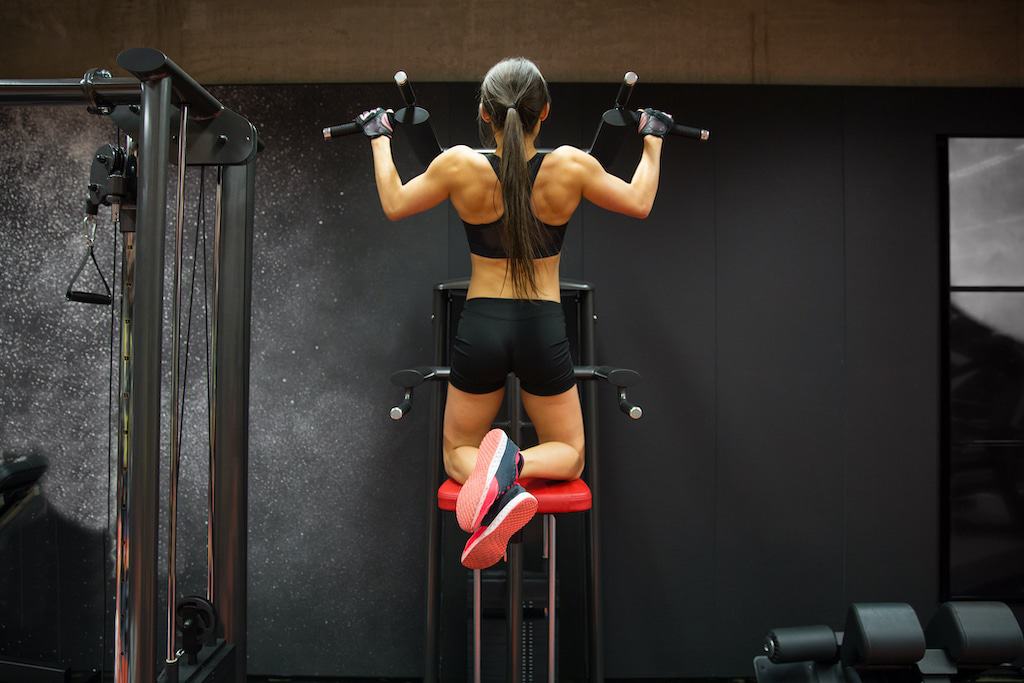Pull-ups are the most popular and well-known calisthenics workout exercise. Calisthenics is a form of exercise that uses natural movements and your body weight to train and work out your body. Through calisthenics, you can gain a myriad of benefits, including the endorphins that are released in your brain that will keep you motivated to do your 100 pull-ups a day. But what exactly will doing 100 pull-ups a day do for you?

When doing pull-ups, you will see the most improvement areas are your arms, shoulders, and upper back. There are plenty of accounts where people have taken this challenge and seen a drastic difference as soon as 15 to 20 days.
When it comes to doing this challenge, there are a few things that are required. First, pull-ups are notorious for being difficult, especially for beginners to calisthenics. With that said, make sure you are in shape if you decide to do 100 pull-ups a day, regardless of how many days you want to do them.
Something to remember is that almost all of the accounts of people doing this challenge say that the first two weeks are very tough. However, it gets much easier after that. Also, do not be ashamed to take a rest day every now and then. While the challenge says 100 pull-ups a day, it does not necessarily mean every day. Rest days are essential to get your body ready for the next set of days you are doing this challenge.
As you continue to read this article, we will be discussing the proper form and equipment that you will need to do 100 pull-ups a day. We will also briefly talk about the benefits of calisthenics. Finally, we will talk about what you should expect to happen to your body as you do 100 pull-ups a day.
How To Do A Pull-Up
A pull-up is an exercise that requires a bar of some sort that you can comfortably grab and suspend your body from. When looking to get the most out of your pull-ups, there are four main points you need to remember.
- Avoid common mistakes
- Use the right grips
- Engage your shoulder blades before pulling up
- Keep your body in the correct positions
- Avoid Common Pull-up Mistakes
First, we will start by talking about the common mistakes people make when attempting pull-ups.
- When you are doing pull-ups, you should always aim to do the full range of the pull-up motion. Do not only do the upper or lower part of the movement. Doing so will result in very little muscle gain and will only serve to strain your muscles.
- You should always do a pull-up with strength and not momentum. Kicking your legs and swinging your body will also drastically reduce the muscle gain of doing pull-ups naturally.
- Keep control of your movement throughout the entire pull-up. Do not come down rapidly after doing a rep and fall into your joints. This can cause pain and injuries that can be pretty severe.
- The last thing to remember is not to pull your body up unevenly. Keep your body straight and try not to angle your body in any direction. Doing so will cause unevenness in your muscles, leading to one side being noticeably more prominent than the other if you do this for too long.
- Use The Right Grips
When doing pull-ups, you can choose from a few different grips. The most common pull-up grips are the wide and narrow grips. Avoid doing extra-wide grips because your elbows will bend too far away from your body. In addition, when you are doing extra-wide grip, pull-ups are not optimized for your shoulders and can lead to pain and injury.
Narrow grips are perfectly okay. You can even keep your hands right next to each other. However, this is also not very optimized. Even though your shoulders are not bending far away from your body, your biceps will not get as much of a workout.
The most optimal grip is to keep your hands on the bar as wide or just wider than your shoulders. This keeps your elbows close enough to your body to properly engage your shoulders and back while also allowing you to work on your biceps.

- Engage Your Shoulder Blades Before Pulling Up
This step is often skipped over, but proper shoulder blade movement is integral for the most optimal pull-up. When you are doing pull-ups, first start by pulling your shoulder blades down. This will slightly lift your body closer to the bar when you do it correctly. After adjusting your shoulder blades, pull your body up with your arms while pinching your shoulder blades together.
Something to remember is to keep your shoulder blades together. Avoid spreading them apart during your pull-up exercise. This is called rounded shoulder position and can lead to unbalanced muscles, pain, and injuries.
- Keeping Your Body In The Right Positions
The last step is just as important as engaging your shoulder blades. Keeping your body in the correct positions will further increase your workout. There are two different body positions for pull-ups.
The first position is called the straight pull-up or the hollow body pull-up. Most people prefer this position because it adds another muscle group to your pull-up exercise. Doing the straight body position keeps your body at a slight angle forward, which uses your core muscles to keep your body straight. The main downside to this type of position is that it slightly neglects your back workout.
The second position is called the arched back pull-up. Most people prefer this position because it solely focuses on the same muscle groups that the pull-up does. In a sense, the arched back position is a small amplifier to the pull-up exercise. As you pull up, arch your back backward and continue the pull-up until your chest touches the bar. Un-arch your back as you return to the starting position.
What Does Doing 100 Pull-ups A Day Do For You?
Pull-ups were designed to be a natural movement that uses your body weight to make you stronger. With that said, pull-ups focus on 3 to 4 main muscle groups: your biceps, your upper back, and your shoulders. If you are doing the straight body pull-up, we described above. You can add your abdominal muscles to this group.
As you can see, pull-ups work on a large number of muscles. As you are doing the 100 pull-ups a day challenge, you will notice all of the muscles getting noticeably more prominent. However, this change will not be noticed right away. Many people who take on this challenge will say they did not see a significant difference until their 15th day at the earliest.
What this means is that you will be doing this challenge for at least two weeks before you start to see a noticeable change. Not only that but the first two weeks of this challenge are said to be the hardest. Some people who do this challenge will say that the first 3 or 4 days are the hardest because your body is getting used to this new intense workout that you are putting it through. At the same time, others say that it does not get easier until much later.
However, everyone says the strength and endurance that you gain from doing this 30-day challenge is insane. The endurance and strength they gained not only helps them increase their maximum reps for pull-ups but these effects are also transferred elsewhere. People have said that they were able to increase their maximum weight and reps by a noticeable amount when it comes to lifting weights.
Something to remember is you do not need to do 100 pull-ups every day. You are entirely within your right to take a rest day to allow your muscles to heal. In fact, many people who do this 100 pull-ups a day challenge say that doing three days in a row and taking one rest day yielded the best results. They were able to see muscle gain sooner and continue the challenge far beyond the 30-day limit.

Benefits Of Doing Pull-ups
Pull-ups are considered to be an advanced calisthenics exercise. While they are not as hard as muscle-ups, they are definitely more challenging than chin-ups. Because of this, there are a few ways to help you build strength to do pull-ups, like using pull-up bands which help by pushing your body up to the bar as you pull up.
However, regardless of how you are going pull-ups, you are gaining a myriad of benefits.
- Strengthening Back Muscles
Doing pull-ups is the most effective workout when you want to strengthen your upper back. This is because pull-ups strengthen the biggest muscle in your back which is the latissimus dorsi. This muscle runs from the middle of your back to under your shoulder blades and into your armpits.
Not only that, but pull-ups also strengthen your traps, the muscles that run the length of your spine, and the muscles that are located on and around your shoulder blades
- Strengthening Your Arms And Shoulders
While pull-ups primarily focus on your upper back, they are also a fantastic exercise to strengthen your shoulders and your arms. You can even work on your abdominal muscles by doing the straight body pull-ups we described above.
- Pull-ups Improve Your Grip Strength
While doing pull-ups, you are gripping a bar and lifting your entire body weight up and down. This will build tremendous grip strength, which will help you in many ways. From helping you hold weights tighter to improving your grip for various sports like tennis and rock climbing.
- Improve Your Physical Health
With the vast array of grips that you can do pull-ups, you can strengthen a large part of your upper body. Doing pull-ups also helps you shred fat which will help combat type 2 diabetes. Not only that, but pull-ups can help reduce blood pressure and can even help alleviate back pain.
- Improve Your Mental Health
As with all forms of exercise, you will notice a positive increase in your mental health. This is because exercising releases endorphins in your brain, which have a ton of benefits.
- Reduce the build-up of stress
- Helps combat anxiety
- Helps combat depression
- Improving self-esteem
- Increase your motivation
Final Thoughts
Doing 100 pull-ups a day can be a daunting task, but you will see a drastic increase in your strength with the right mindset and motivation. Remember to take rest days if you need to, and remember to do pull-ups properly to reduce the likelihood of pain or injury.

